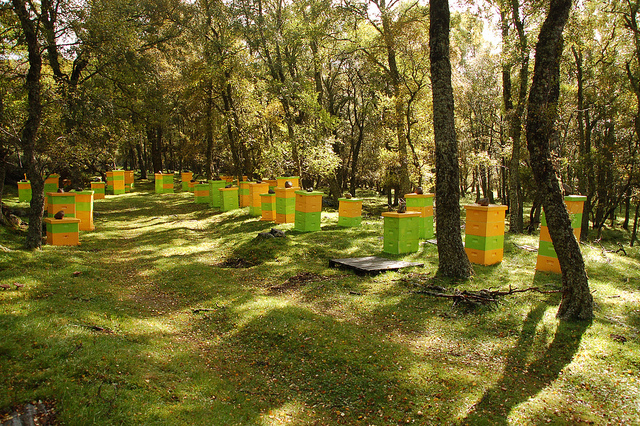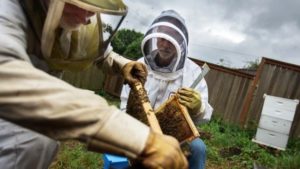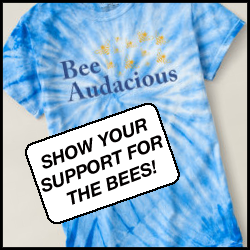Audacious Idea Five: Breed for Disease Resistance & Focus on Commercial Beekeepers
Breed for Disease Resistance & Focus on Commercial Beekeepers
Francis Ratnieks
According to Aizen and Harder (2009) the number of managed honey bee colonies worldwide increased 45% in the latter half of the 20th century. At the same time African honey bees spread across tropical and sub-tropical America resulting in tens of millions of additional wild colonies. Honey bees have also been introduced into N. America, Australia and much of Asia from their native home in Europe, Africa and the Middle Eact. In short, there are now more honey bees, Apis mellifera, on Earth than at any time in the past.

Bee hives in Tigaki on the Greek island of Kos.
So why all the fuss about honey bee declines? The reason is that declines in certain areas, such as the USA, have been well publicised (the press love doom and gloom stories) and have resulted in a more general awareness, including in the minds of politicians (often fuelled by activists who have suddenly found an interest in bees and in some cases use bees to help their own agenda), of two things that beekeepers, farmers and scientists have known for more than 100 years: 1) honey bees suffer from diseases that can kill colonies; 2) honey bees are important for crop pollination.
These two factors are of great importance both now and in the foreseeable future. The challenge posed by diseases is unlikely to go away and is exacerbated by the global spread of once regional pests and diseases, including pests such as the mite Varroa destructor that have moved to A. mellifera worldwide from other Apis species. Varroa is probably at the heart of many disease problems in European honey bees, as varroa can vector and worsen existing viral diseases.
The need for managed honey bee hives to be moved into crops for pollination is likely to grow as greater crop yields are required to feed the increasing human population, as bee-pollinated crops become a more important part of our diet, and as areas of intensive agriculture requiring crop pollination exceed the pollination ability and flight range of “local” bees. Indeed, intensive agriculture will often greatly reduce the number of local bees, whether they are honey bees kept by small scale beekeepers or wild species.

Attempts to facilitate crop pollination by encouraging populations of wild and feral bees, and also small scale beekeeping with Apis mellifera, are worthwhile. However, they are unlikely to provide sufficient pollination in places where bee-pollinated crops cover large areas and agriculture is intensive (e.g., the Central Valley of California).
Large-scale commercial beekeeping is a key part of crop pollination in the USA and is also the type of beekeeping that is most divorced from the natural processes that may reduce diseases. Commercial beekeeping is a good way of spreading diseases among hives, and is likely not a good background for both the evolution of natural resistance in the bees and low virulence in the pathogens. By treating diseases with chemicals, commercial beekeepers reduce natural selection for resistance. By keeping hives close together, by moving hives, and by restocking dead hives, commercial beekeeping facilitates horizontal disease transmission and more virulent pathogen strains.
So what can be done? My audacious idea is that the key need is to ensure that commercial beekeeping is sustainable in the face of diseases. For crop pollination, and to a lesser degree for honey production, we do need commercial beekeepers who keep large numbers of hives and who can move them in and out of crop areas, sometimes over long distances.
What can we do to help commercial beekeepers? Commercial beekeepers manage and treat their hives and, at least in the USA, often purchase queens from queen rearers and use these to requeen colonies and make up increase. Rather than have commercial beekeepers put most of their disease-control time, money and effort into treating hives with chemicals, I suggest that this would be better spent if disease management efforts were more aimed at improving natural disease resistance. One way of doing this is to encourage the breeding and selection of bees that shows high levels of hygienic behaviour.
Research has shown that hygienic behaviour can greatly reduce many honey bee diseases. In the USA, work by Marla Spivak has shown that hygienic behaviour lowers levels of chalkbrood, American foulbrood, and varroa and increases honey production. In my lab at Sussex University we have shown that hygienic behaviour reduces annual varroa population growth by 50-60%, reduces levels of deformed wing virus by 10,000 times, and, by requeening with a hygienic queen, can even “save the life” of a colony in which workers with deformed wings are seen. Normally, this is a harbinger of death.
Aizen, M. A., Harder, L. D. 2009. The global stock of domesticated honey bees is growing slower than agricultural demand for pollination. Current Biology 19: 1-4.
Get your tickets – help the bees.
 Previous Post
Previous Post



